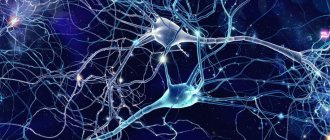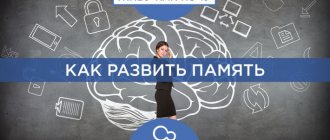Memory and attention are interrelated functions of human thinking. Without the ability to concentrate on the object of memorization and get an emotional return from studying this object, it is impossible to qualitatively learn the necessary material. In fact, a person’s attentiveness and interest are the main factors in their short-term memory.
This lesson provides information on how to train and develop attention and memory using special techniques and exercises, as well as recommendations for getting a vivid impression of the material being studied.
Is the brain not a place for memory?
Representatives of neuroscience have been busy localizing various cognitive processes for many years: they are looking for specific parts of the human brain responsible for certain higher mental functions.
If reports are to be believed, scientists have already discovered areas associated with appetite, fear, excitement and even the ability to recognize lies, not to mention the perception of one's own personality. But the place where our memory could be “stored” has not yet been found. “The first person to discover this zone will probably be awarded not only the Nobel Prize, but will also be included in the cohort of the most outstanding scientists,” says Soviet and Russian biologist, specialist in the field of cellular mechanisms of memory and learning Pavel Balaban.
Memory is believed to consist of:
- sensory register, where information from the senses is received: visual - into iconic memory (where ~ 0.5 seconds is stored), auditory - into echoic (3-8 seconds);
- working - short-term - memory (~ 18–30 seconds);
- long-term memory.
When remembering something, we do not retrieve information from some kind of storage. Memories are created anew every time.
Russian neuroscientist Konstantin Anokhin believes that information “travels,” being formed in some brain structures and “extracted” from others. Whenever we “remember” something, we “forget” it, replacing it with a new one - we can say that the brain “overwrites” memories, although this definition is incorrect, since the memory carrier, we repeat, has not yet been discovered.
American psychiatrist, neuroscientist and professor of biochemistry Eric Kandel compares the brain to a wiring diagram of an unimaginable number of neuronal contact points. Let's take an experimental dog: if you hit it with a light electric shock when turning on the light, the light bulb will come on every time, causing stress, fear and generally unpleasant sensations. If you give meat at every “light signal”, the dog will “forget” fear and “love” the light - the switched on lamp will become a harbinger of joyful events for it. Simply put, this happens because in each case, information about light enters different areas of the brain. In the first - those responsible for defense, in the second - for digestion.
Kandel argues that this is due to prion-like proteins that act as “routers” at the contact points of neurons.
As prions age, they transmit information to new growth - this is the process of so-called protein heredity, which occurs between proteins without the participation of DNA.
This hypothesis is proposed by Kandel as an explanation of the memory mechanism.
If there are violations
Impairments of both memory and attention are quite common. The brain ceases to orient itself correctly, communication with other processes is lost, and problems arise. Experts offer a number of solutions to restore memory and adjust concentration.
One of the correction options is memorizing poetry. Thinking catches the connection between the repetition of the same thing, and memorization occurs. Naturally, this requires careful concentration. It is enough to teach a verse a day to restore the connection.
Alternatively, use flexible thinking - memorize phone numbers from your mobile phone book. This will allow you to not be left without communication in a difficult situation, and will also train your memory.
Imaginative thinking is another option to restore attention and develop memory. It is enough to make many associations about one thing or another, so that later you can remember the necessary information from them and concentrate on it.
An excellent option for working with cognitive processes would be to play “detective”. You just need to periodically remember what you were doing yesterday at this time, and the day before yesterday? Thinking will quickly and helpfully suggest the correct answer.
You need to constantly engage in your mental development. With age, memory capabilities and concentration decrease. Therefore, it is worth playing it safe in advance and starting training from a young age.
Moreover, this is not so difficult to do, since there are a huge number of techniques, as well as a large number of doctors who specialize in disorders in the field of cognitive processes and in their strengthening. If you follow the recommendations regularly and according to instructions, you will have a bright and sharp mind. This will allow you to cope with various tasks faster and easier, solving them instantly.
Additionally, help yourself by taking vitamins and minerals. This will strengthen blood vessels, improve memory and concentration abilities, and so on. Also, do not forget about a rational daily routine, so that walks in the fresh air feed the brain with sufficient oxygen and contribute to its better functioning. Take care of yourself, and then you will always be healthy - both physically and mentally.
Is a complete mapping of our brain impossible?
The project of mapping all the connection points of neurons is called connectome. So far, we have only been able to describe the connectome of a nematode worm measuring about 1 mm, whose nervous system consists of just over 300 neurons.
As for describing the connectome of the human brain, which contains ~86 billion nerve cells, there is still no general idea of the scale of this project.
What is clear is that it is much more complex than deciphering the human genome or even the proteome (a set of proteins).
Scientists, for example, are attempting to describe the rat brain in this way. “We mapped an area the size of a match head - it took terabytes of memory. And it’s not clear what to do with such a volume of information,” says Russian anthropologist and popularizer of science Stanislav Drobyshevsky. He emphasizes that the problem is that we are trying to comprehend the results of these studies “with the same brain, which no longer accommodates information about itself - it turns out to be a vicious circle.” To understand how our brains work, we need a “bigger brain than ours.”
What helps and what hinders memorization?
Motivation is an important component in the process of memorizing any amount of information. To stay focused, always use self-motivation.
For example, the task is set to remember this material. This will bring great benefits in the future for your self-development, career, family. Speak out all the benefits of studying and applying this information. The more you feel the need for these actions, the more effective the memorization process will be.
You will find everything about motivation in the article: “What is positive motivation and how it will move mountains for you.”
External noise. Are you able to concentrate on work when there is turmoil all around? Most often it is an acquired skill, a habit.
If a person lives in a small apartment or student dormitory, his brain is forced to adapt to difficult conditions and do its work without paying attention to external stimuli.
Difficulties make us stronger. To increase your “impenetrability” threshold, I recommend artificially creating difficulties for yourself. For example, concentrate on reading while music is playing in your headphones, write a progress report while sitting in McDonald's, where people are walking around and making noise. This will tire you out faster, but the results will not be long in coming.
It's a pity there is no Mr. and Mrs. Impenetrable award. I’m sure you could claim first place after such training.
Are all people cyborgs?
Philosopher and scientist Andy Clarke believes that the human mind is always more than what “happens inside an ancient fortress of skin and skull.”
Clark blurs the boundaries between the "inner mind" and the "outer world" and argues that the human mind has always been externalized - extended outward.
The mind, according to Clark, is what is scattered in the things around us, external means of storing and retaining information, be it a paper notebook, a road sign, a store sign or a computer.
In this sense, we are all - no less than - cyborgs. And they always have been.
Clark rejects the idea of a separate “I”, but considers it promising not only to “expand outward”, but also inward, since “consciousness is <...> a huge, quiet cave of underground mental mechanisms, with its pipes, synapses and electrical impulses that form a pulsating substrate of the self. <…> When you think about all these fundamental mechanisms - ancient and shared with other mammals and distant ancestors <...> consciousness can seem like just a surface phenomenon, a user interface obscuring the real workings at lower levels.”
Ryuta Kawashima's Intelligence Development System
Japan is known for progress in almost every field. It was here that the Japanese system of intelligence development was developed.
According to Ryuta Kawashima's original method, solving simple timed arithmetic problems and reading aloud engages all hemispheres of the brain. In this way, memory is trained and developed, and negative consequences are erased. Reading helps slow down brain aging.
The author conducted an experiment among mentally ill patients suffering from dementia and Alzheimer's disease. After 30 days of training according to the Kawashima system, patients showed a slowdown in the development of the disease. Brain function improved significantly. It was previously almost impossible to delay the suppression of cognitive functions in this disease. The author's book itself consists of a number of simple arithmetic tasks, visual illustrations and comments.
Is attention a fiction?
The first theoretical model of attention, the filter theory, was created by the English experimental psychologist Donald Broadbent.
According to this theory, the nervous system carries out selection by working as a single communication channel (with multiple inputs). The choice of this or that information may depend on the state of the body, external physical conditions (sound volume, for example) or psychological attitudes (the mood to accept this or that information). The filter blocks the remaining channels, but “the unclaimed one is stored for some time in a short-term storage unit, and then can pass through the communication channel - if there is a shift in the selective process from one class of sensory events to another.”
This model was later expanded by attention psychology researcher Anne Trisman. According to her findings, the entire flow of information comes through many parallel channels. The filter “passes” some signals, and attenuates others. Both the first and second pass through a “logical analyzer”, operating on the basis of a conditional “individual’s dictionary”.
And the Danish psychologist, philosopher and teacher Edgar Rubin, in his report with the telling title “The Non-Existence of Attention,” made more radical conclusions:
“The term “attention” does not mean anything definite and concrete <...> to put it in correspondence with a certain reality.
When, for example, a certain Mayer looks at his notebook, it can be pseudoscientifically expressed as follows: “Mayer directed his attention to the notebook.”
Apparently, they say this not only for the sake of sophistication of expression, but also in order to open the way to the dangerous misunderstanding that in our cognitive life there is a kind of spotlight that moves here and there over the perceived object.
Thinking
Note 2
Thinking is understood as the process of human mental activity, the highest form of his creative activity.
The distinctive features of thinking include the creative processing of existing ideas and the creation of new ones, the ability to reflect both individual objects, phenomena, properties, and the connections that exist between them, an indirect reflection of the surrounding world.
Classification of thinking occurs on different grounds. The division into theoretical and practical thinking based on the nature of the problems being solved is most often used.
In terms of the degree of development, it can be discursive and intuitive, and in terms of originality, reproductive and productive thinking are distinguished.
Thinking is also classified according to form - visual-effective, visual-figurative, verbal-logical. Visual-effective thinking is quite often used in everyday life and is aimed at solving practical actions, for example, you need to learn how to press buttons on a tape recorder. This most elementary form of thinking is the basis for the formation of its more complex types. The basis of visual-figurative thinking is perception or representation, because problems are solved through images.
It must be said that ways of thinking and images of perception differ from each other in their generality and abstraction - only the important and most essential properties are reflected in the ways of thinking.
Verbal-logical thinking refers to conceptual thinking; problem solving occurs through reasoning. A concept is the essential properties of phenomena and objects in the surrounding world, which are divided into general and specific. If, for example, an apple or birch tree is planted, and not just a tree, then this is a specific concept.
It is human nature to reason while thinking. Judgments can be general, particular, or individual.
As for general judgments, they contain information about all objects and phenomena, both affirmative and negative. Private judgments include only part of the objects and phenomena that are included in the concept. With a single judgment, we are talking about an individual concept, for example, Tanya draws excellently. In the course of any reasoning, conclusions are drawn that create new judgments. The new judgment is called inference.
If an inference is made from the particular to the general, then it will be induction, and the reverse process is called deduction.
In reality, there are a huge number of types of thinking that are interconnected. People differ from each other in the quality of thinking - the breadth and depth of the mind, independence of thinking, its flexibility, speed and criticality.
The development of thinking occurs in the process of mastering knowledge, the sources of which are school, books, the media, radio and television, etc.










